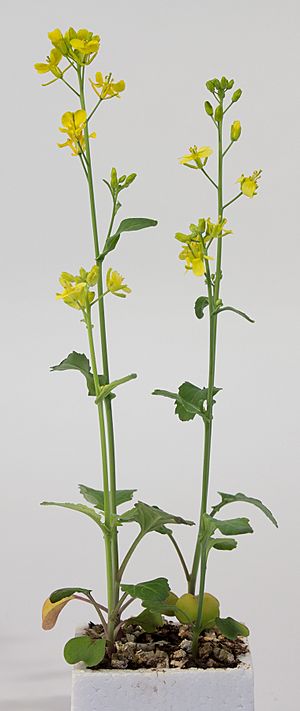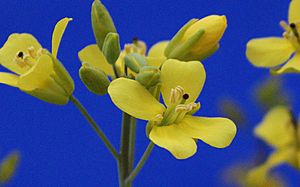Wisconsin Fast Plants facts for kids
Quick facts for kids Wisconsin Fast Plants |
|
|---|---|
 |
|
| Subspecies | Brassica rapa subsp. dichotoma |
Wisconsin Fast Plants are a special type of plant, like a specific kind of dog breed. They are a registered trademark for a plant called Brassica rapa. Scientists and teachers use them because they grow very fast. These plants are related to vegetables like turnips and bok choy.
Fast Plants were created to help scientists study plants quickly. Their speedy life cycle also makes them great for classrooms. Students can easily grow many plants indoors. For many years, Fast Plants have been used in schools and labs all over the world.
Contents
Where Did Fast Plants Come From?
Wisconsin Fast Plants started in the early 1970s. They were part of a bigger project to create "Rapid-Cycling Brassicas." The goal was to make plant research faster. Scientists wanted to find ways to make important crops resistant to diseases.
By making plants with shorter life cycles, many generations could grow in a short time. This was much faster than older types of Brassicas. Fast Plants were also bred to need little soil and grow well under bright lights. They don't need a resting period before their seeds can sprout. These features made them perfect for labs, allowing many plants to be grown in small spaces. These same qualities also made them excellent for school projects. Students and teachers can grow several generations of plants indoors during the school year.
Professor Paul H. Williams, from the University of Wisconsin-Madison, first thought of creating these plants. He wanted a plant that would help him improve his research. Professor Williams collected over 2,000 different types of Brassica plants. He grew them and found a few plants in each group that grew and flowered much faster than the others. He chose these fast-flowering plants to create the Rapid-Cycling Brassica groups. From these groups came Rapid-Cycling Brassica rapa, which later became known as Wisconsin Fast Plants.
How Were Fast Plants Chosen?
Wisconsin Fast Plants are still being improved today. This is done using traditional plant breeding, not modern genetic engineering. Scientists focused on several important features to create the best plant for research and learning:
- They grow from seed to seed very quickly.
- They produce lots of seeds.
- Their seeds can sprout right away, without needing to rest.
- They grow flowers and seeds quickly, no matter how much light they get.
- All the plants flower at about the same time.
- They can grow close together without problems.
- They grow well under constant, bright artificial lights in labs.
- They can grow in small amounts of soil that is easy to prepare.
- They keep a good variety of genes within their fast-growing groups.
What Kind of Plant Are They?
The Brassica family has many different kinds of plants. They can look very different from each other. One way they differ is how long it takes them to grow from seed to seed. Brassicas that have been bred to grow very quickly are called Rapid Cycling Brassicas. Wisconsin Fast Plants belong to the Brassica rapa group.
Since the first Fast Plants were created, scientists have continued to breed them. This helps keep the plants healthy and diverse. Even though Fast Plants came from many different Brassica types, they look most like a plant called brown sarson. This plant is an oilseed crop from the western Himalayas. So, scientists sometimes call Wisconsin Fast Plants Brassica rapa ssp. dichotoma.
Where Do Fast Plants Grow?
Many Brassica plants can be found growing wild around the world. However, Wisconsin Fast Plants were made to grow indoors for experiments. They usually do not survive well in the wild.
Fast Plants can handle different conditions, but they grow best in certain ways. If conditions are not ideal, they might grow slower or produce fewer seeds. The best conditions for Wisconsin Fast Plants include:
- Continuous, bright light for 24 hours a day.
- Temperatures between 65–78 degrees F (18-25C).
- Fine, airy soil that drains well.
- Constant water supply, often through a special wicking system.
- Fertilizer, either slow-release pellets or liquid.
The Life Cycle of Fast Plants
Wisconsin Fast Plants have a super short life cycle. If they are grown in perfect conditions, they will have flowers in just 14 days. They will produce seeds ready to harvest about 40 days after planting. The steps below describe how Fast Plants grow in ideal conditions. If conditions are not perfect, they will grow slower.
Days 1-2: Starting to Grow
After you plant and water a seed, it starts to sprout. The seed soaks up water and swells. Its outer coat cracks open. The first part to come out of the seed is the root.
Day 3: Hello World!
The stem, called the hypocotyl, pushes up through the soil. It pulls the seed leaves, called cotyledons, with it. The seed coat falls off the cotyledons. You might see green chlorophyll and purple pigments as soon as the tiny plant appears.
Day 4: Roots and Stems Grow
Above the ground, the stem gets longer as the plant reaches for light. Underground, the roots grow deeper. They help anchor the seedling in the soil.
Days 5-8: More Leaves and Roots
Above ground, the main stem gets longer. New, true leaves grow from the very top of the plant. This top part is called the apical meristem. Underground, the roots grow tiny hairs. These hairs help the roots soak up more water and nutrients from the soil.
Days 9-13: Flower Buds Appear
The plant starts to get ready for reproduction. It stops growing new stems and leaves. Instead, it begins to grow flower buds. These buds also grow from the apical meristem at the top of the plant.
Days 14-17: Flowers Bloom and Pollination
The flowers open up. The stamens release pollen from their tips, called anthers. The pistils, which are the female parts, become ready to receive pollen at their sticky tips, called stigmas. If pollen moves from one flower to another, pollination happens. Pollen that lands on a stigma grows a tube down into the pistil, where the eggs are. Sperm from the pollen then travel down this tube to reach the eggs, and fertilization happens. Fast Plants cannot pollinate themselves. This means pollen must come from a different Fast Plant for seeds to form.
Days 18-20: Seeds Begin to Form
The fertilized eggs inside the flowers' pistils start to grow. They become the tiny new plants, called embryos, inside future seeds. The outside of the pistil swells up. It becomes the seed pod, which holds several seeds.
Days 21-40: Seeds Get Ready
The flower petals slowly wilt and fall off. Inside the seed pods, the embryos continue to grow and mature. About 20 days after the last pollination, the plants are taken out of water. They are allowed to dry. This drying helps the seeds ripen. When the plants are brown, dry, and brittle, the seeds can be collected. They can then be stored or planted again. Inside each seed is a tiny embryo, waiting for water and warmth to sprout into a new plant. This starts the life cycle all over again!
Why Are Fast Plants Important?
Because they grow so fast, are easy to grow, and react to their environment, Wisconsin Fast Plants are used for many things. They are great for both learning and scientific research.
Learning in Schools
The Wisconsin Fast Plants Program started at the University of Wisconsin-Madison. It was created to help teachers use these plants in their lessons. This program still exists today. It works with teachers to create lesson plans, experiment guides, and even plans to build your own growing systems. The goal is to help everyone learn with Fast Plants. All these resources are available online for free.
Wisconsin Fast Plants are used to teach about many topics. These include plant life cycles, plant parts, how plants reproduce, how traits are passed down, and how plants interact with their environment. Students also use Fast Plants for their own science projects, like for Science Olympiad.
Helping Scientists Learn
Fast Plants let scientists grow many plants quickly in a small space. They don't even need a greenhouse. Because of this, Fast Plants are used in many different types of research. For example, in May 2022, searching for "Wisconsin Fast Plants" found almost 1,000 research papers! These papers covered topics like how plants handle dry weather, how pollen grows, how pollinators behave, and how to change plant genes.
Fast Plants have even been used in space research! In 1997, on the Mir Space Station, Wisconsin Fast Plants were the first seeds to sprout in space from plants that were also grown, pollinated, and harvested in space.


